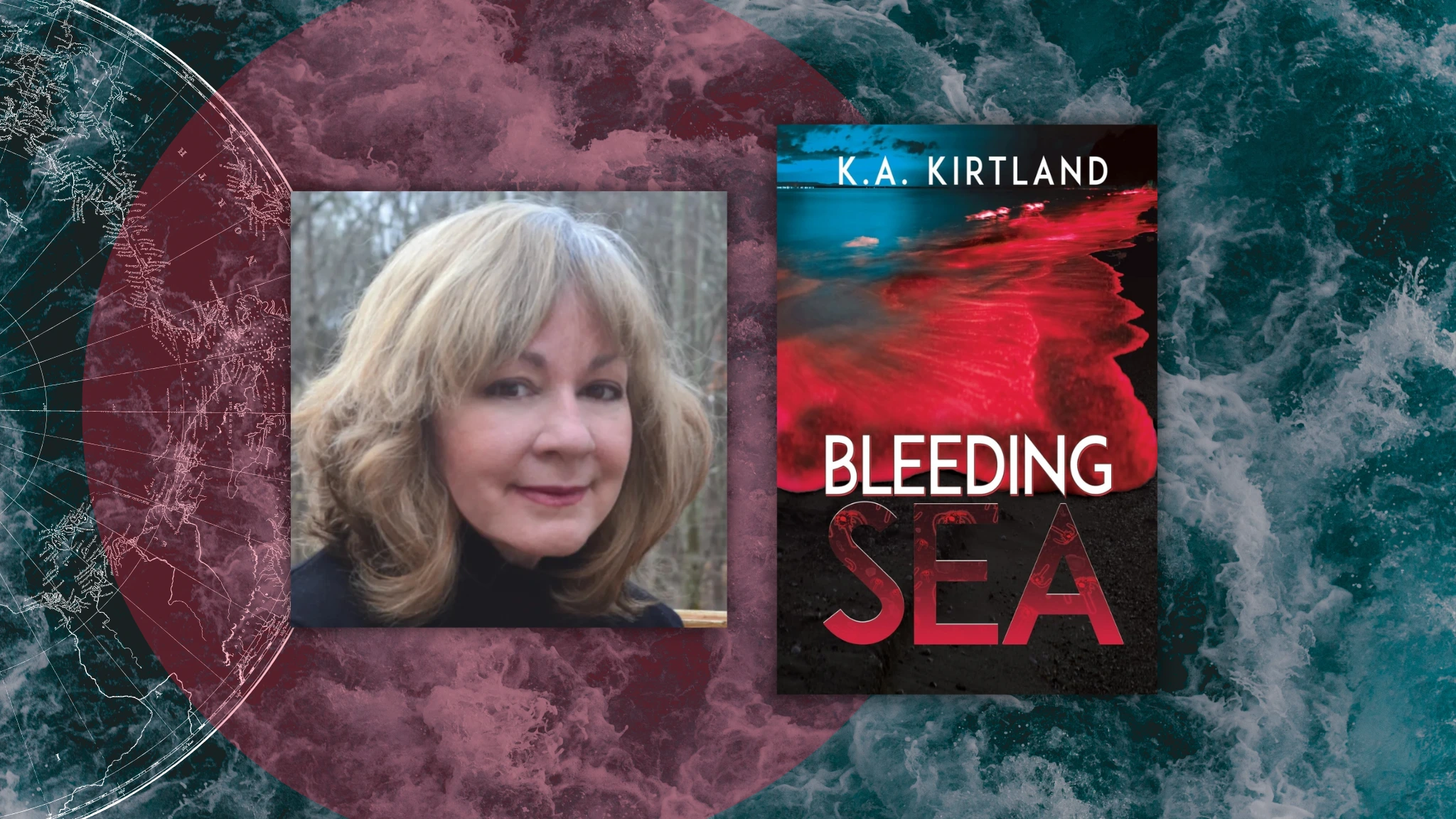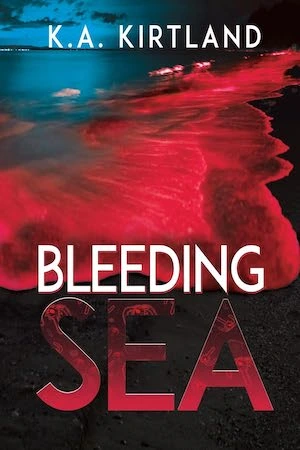
Bleeding Sea by K.A. Kirtland
While a threat to the planet grows more urgent, self-interested leaders of industry go to great lengths to keep the public in the dark — while all continuing the practices that worsen the problem. Sound familiar?
It seems we’ve seen this narrative play out with increasing regularity in today’s news; from climate change increasing the severity of hurricanes to the megadrought of the West coast, human handprints are all over the natural disasters of the modern age. It’s certainly not a pattern lost on author K.A. Kirtland, who holds a Master of Science in Marine Biology and a PhD in Environmental Health Sciences. She took that expertise and used it to craft Bleeding Sea, an eco-thriller that holds a mirror to modern society and the effect it’s having on the planet we call home.
Blending the large-scale stakes of environmental horror with the slick, adrenalizing pace of a crime thriller, Bleeding Sea is a book that’s sure to stay with readers far after the last page. And in the Q&A below, we had the opportunity to speak with Kirtland about scientific accuracy, stand-out characters and what makes the sea such a terrifying setting for an eco-thriller.
Q: In Bleeding Sea, Diane Nelson uncovers a conspiracy while investigating the red tide. What inspired you to explore the intersection of environmental crisis and corporate malfeasance in this story?
A: The intersection of environmental crisis and greed in Bleeding Sea reflects a reality often seen today, where corruption contributes to environmental degradation while remaining hidden from public scrutiny. The story highlights how unchecked industrial practices can exacerbate natural disasters, like the red tide, turning them into catastrophes. Through Diane’s investigation, the novel explores the tension between those who profit from exploiting natural resources and those who fight to expose the truth, illustrating the broader theme of accountability in the face of environmental collapse.
Q: The concept of an invasive species destroying the ocean’s ecosystem is terrifyingly plausible. How much of the science in your book is based on real-world research, and what message do you hope readers take away regarding environmental threats?
A: The science in Bleeding Sea is heavily rooted in real-world research. Harmful algal blooms, like the red tide featured in the book, are real phenomena that can have devastating effects on marine ecosystems, human health and local economies. While the specific events in the novel are fictional, they’re inspired by actual scientific studies on how climate change, pollution and human activities can accelerate these natural processes. The message I hope readers take away is that environmental threats are not distant or theoretical — they’re already happening around us. By understanding how delicate our ecosystems are and how human actions can tip the balance, we can take meaningful steps toward protecting our oceans.
Q: Diane is an inexperienced but passionate scientist thrown into a dangerous situation. What challenges did you face in writing her character, and how does her personal growth parallel the escalating environmental crisis?
A: Writing Diane’s character required balancing her scientific curiosity with her vulnerability in an increasingly dangerous situation. As a novice scientist, she begins with a strong desire to make a difference but is unprepared for the complex, high-stakes environment she’s thrust into. Her personal growth mirrors the escalating environmental crisis — as the red tide intensifies, Diane must confront her own limitations, fears and moral dilemmas. As the disaster spirals out of control, she realizes that scientific knowledge alone isn’t enough — courage, adaptability and risk-taking become equally vital. Diane’s journey reflects the urgency of action and personal accountability in addressing mounting environmental challenges, highlighting the need for more than just scientific understanding.
Q: The novel hints at a larger conspiracy behind the red tide. Can you share how you crafted the thriller elements while balancing the scientific realism of the ecological disaster?
A: Balancing thriller elements with scientific realism meant finding the right mix of fact and fiction. The ecological disaster — the red tide — is grounded in real-world science, but I heightened tension by introducing a larger conspiracy that raises the stakes beyond a natural event. Diane’s investigation reveals hidden agendas and selfish interests linked to the environmental crisis, adding layers of mystery and suspense. The key was keeping the science plausible while allowing room for intrigue, corruption and twists. By ensuring the science remained accurate, the thriller elements could develop organically, making the conspiracy feel both unsettling and believable within the story’s context. This balance made the narrative gripping while staying true to scientific realism.
Q: The ocean is often portrayed as mysterious and powerful in literature. How did you use the setting of the Gulf of Mexico to build tension and atmosphere in the novel?
A: The Gulf of Mexico serves as a perfect backdrop to heighten the tension in Bleeding Sea. Its vast, murky waters evoke both awe and unease, mirroring the growing threat of the red tide. The hidden depths conceal natural dangers and secrets tied to the unfolding conspiracy. Similarly, scenes set in the North Atlantic emphasize the ocean’s unpredictable nature, shifting from calm to violent, enhancing the sense of danger. By portraying the ocean as a powerful, ever-present force — beautiful yet threatening — I created an atmosphere where nature feels like an antagonist, capable of turning deadly at any moment.
Q: Your book brings attention to the fragility of marine ecosystems. What do you think needs to change in terms of global environmental policy to address the kind of threats you explore in Bleeding Sea?
A: To address the environmental threats explored in Bleeding Sea, global policy must prioritize marine ecosystem protection. Stricter regulations are needed to reduce pollution, including agricultural runoff and industrial waste, which fuel harmful algal blooms like red tides. Stronger international agreements are crucial to combat climate change, as rising ocean temperatures and acidification exacerbate these threats. Investment in sustainable practices, such as reducing overfishing and promoting clean energy, is essential. Prevention is key — policy changes must hold industries accountable and promote conservation. Protecting our oceans is a global responsibility, requiring collaboration among nations, scientists, and industries to safeguard these ecosystems before it’s too late.
Q: With climate change and environmental issues becoming more prevalent in fiction, what do you think sets Bleeding Sea apart from other eco-thrillers, and how does it contribute to the broader conversation about our planet’s future?
A: Bleeding Sea offers a distinctive blend of scientific insight into environmental disaster, interwoven with a complex human narrative. The novel highlights the real-world impact of harmful algal blooms and the fragility of marine ecosystems, while exploring the moral dilemmas and exploitation that exacerbate these crises. Blending scientific accuracy with a gripping conspiracy, Bleeding Sea not only entertains but also urges readers to reflect on how human activity accelerates environmental degradation and the need for accountability. It adds to the broader conversation by illustrating that the consequences of inaction are not just theoretical — they’re already making an impact, with significant implications for the future of our planet.

Publish Date: September 18, 2024
Genre: Thrillers
Author: K.A. Kirtland
Page Count: 321 pages
Publisher: Black Rose Writing
ISBN: 9781685134839
Discover more from reviewer4you.com
Subscribe to get the latest posts to your email.




